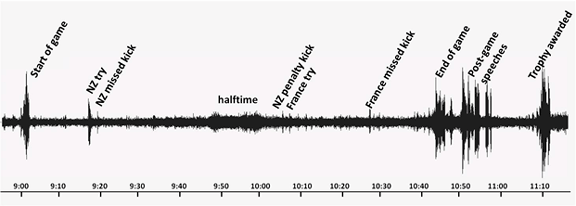The earth really does move for rugby fans
Friday 28 October 2011, 1:09PM
395 views

The exciting final game on Sunday translated into real, groundshaking data for the seismologists at the University of Auckland’s Institute of Earth Science and Engineering (IESE), who recorded the real time impact of the cheering crowd at Eden Park with an earthquake sensor (seismometer) buried beneath the stadium.
This seismometer is capable of picking up extremely tiny vibrations in the earth. These are specifically designed to pick up small earthquakes and other natural signals, but are also capable of detecting even small human-generated noises, such as trains and nearby construction. “60,000 fans cheering wildly for their teams have had a bit more of an impact,” says Annie Zaino, the geophysics technician who processed the data.
The seismogram shows an increase in activity from the moment the gates to Eden Park opened on Sunday evening. Huge additional spikes in the data correspond to the opening haka, the All Blacks try, and various other notable plays. The enthusiasm at the end of the game can clearly be seen, with a particularly strong response both to McCaw’s speech and the awarding of the trophy.
IESE installed these seismometers at 400 and 25 metres deep under the stadium in 2008. This project is part of the University’s interest in helping to tell the story of the subterranean rock layers under Auckland, permitting an underground view of the city.
Liam Wotherspoon, Research Fellow at The University of Auckland says, “The Borehole Instrument Centre for Eden Park (BICEP) aims to evaluate how the earth’s movement affects the stadium, as well as how building movement affects the earth, especially when the stadium holds a large excited crowd during the World Cup.”
The instruments also may be used to alert scientists to potential hazards. With the ability to record tiny earthquakes, with sizes down to magnitude -1 on the Richter scale, deep borehole seismometers may be a tool to explore the existence of faults under Auckland. Also, if magma comes up from the deep earth to threaten Auckland with a volcanic eruption, these seismometers may act as the first warning. It is expected that the magma movement would cause earthquakes for which the borehole seismometers act as an early detection system. The BICEP borehole is linked to a network of 11 seismometers in Auckland, including 6 in boreholes, monitored by GeoNet.